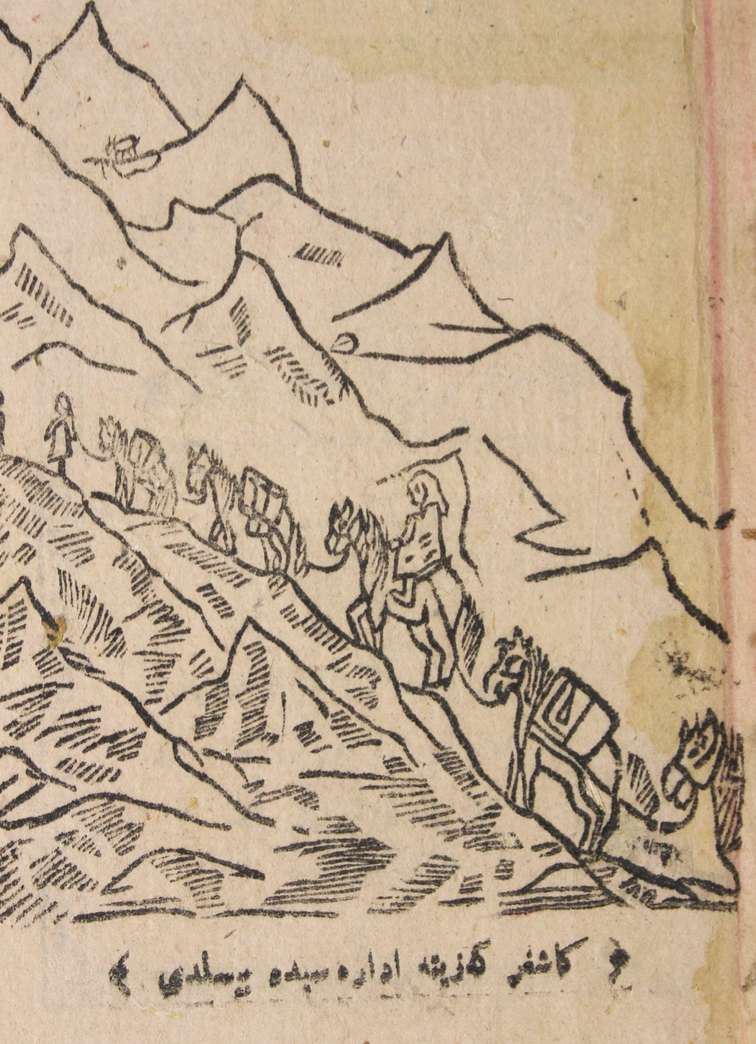Ladakh yolida karwan
[A caravan on the road to Ladakh]
Ähmäd Ziya’i
Summary
In the introductory part of the book Ladakh yolida karwan [A caravan on the road to Ladakh], the author explains that he was imprisoned in Urumchi by the Kuomintang (Nationalist Chinese) regime for a period of 552 days in 1945–1946. After his release from jail he returned to Kashgar, where he engaged himself in trade between Kashgar and India for some time in order to avoid the risk of being arrested again. Ähmäd Ziya’i started preparing for the Ladakh trip in July 1946 and on December 17, 1946, he set out on his caravan journey to this town in the mountains of Indian Kashmir. After his return, Ähmäd Ziya’i wrote down observations and experiences from his excursion. In the first part of the book, the author describes his varied and harsh caravan experiences from Kargalik to Ladakh. In the second part, Ähmäd Ziya’i discusses his investigations and personal feelings about the journey and the people of Ladakh. The book provides a detailed account of the language, culture, religion, folklore and daily life of local people.
.
Comments on the book and its author
The full title (in the Arabic script) on the cover of the book is Ladakh yolida karwan – Kashighär Shinjang gaziti idarisindä basildi, 34-yil, with the second part meaning “– printed by the Kashgar Xinjiang Daily, in the year 34”. As to the year noted, some researchers have erroneously assumed that the book was printed at the Swedish Mission Press in Kashgar in 1934. However, this is not correct. During the Kuomintang (Nationalist Chinese) period, all calendars had to be changed into the Minguo Calendar (China’s Republican calendar), which started in 1912. Even the Uyghurs in Xinjiang were forced to use the Minguo calendar in officially printed books and documents. Therefore, in this case, “the year 34” does not mean “1934 AD” but in actual fact “1947 AD”.
Ähmäd Ziya’I (1913–1989) is one of the most prominent representatives of 20th-century Uyghur literature. He was born amd grew up in Kashgar, where he went to both the traditional madrasa and to modern schools for his education. At the beginning of the 1930s, the young poet started to play an active role in modern Uyghur cultural circles in his hometown, Kashgar. His first professional engagement related to cultural activities occurred at the “East Turkestan Life”, the newly established newspaper which was published by the Government of the short lived East Turkestan Islamic Republic (July, 1933 – March, 1934). After the collapse of the ETIR, the Uyghur-language newspaper changed its name to “New Life”. In 1935, under the control of the Soviet-backed Urumchi government, the name was changed to “Kashgar Xinjiang Daily”. The young poet and editor Ähmäd Ziya’i continued working as editor and chief editor at the Kashgar Xinjiang daily until the end of 1949. During these years, he published a considerable amount of of literary works, such as Tozimas chechäklär (Evergreen blossoms), Wijdan wä muhakimä (Conscience and thought), Rabiyä-Sä’idin (Rabiya and Saidin), and the abovementioned Ladakh yolida karwan.
Uyghur scholars believe that the poetry by Ähmäd Ziya’i constitutes a bridge between classical Turki literature and modern Uyghur literature. Ladakh yolida karwanis a typical example of the prose written by Ähmäd Ziya’i. Today, it is very difficult to obtain a copy of this book in Xinjiang, but fortunately enough, late Gunnar Jarring preserved a copy of it in his his private library. Among scholars of Uyghur literature, Ladakh yolida karwan is generally considered to be the first travelogue written in modern Uyghur.
.
Dr. Äsäd Sulayman, Washington D.C.
